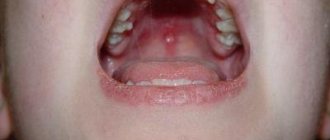Causes of measles in children
This virus is transmitted through the air during sneezing or coughing. It is worth noting that this virus is quite unstable in the environment and dies quickly. When exposed to light in saliva, the measles virus dies literally within five minutes, and when it dries, it dies immediately. Along with this, measles perfectly withstands the effects of low temperatures. Thus, at temperatures down to -70º C, the virus can exist for about five years. Children aged 4-5 years are most susceptible to this disease.
Main features
The process of measles disease can be divided into four periods:
- incubation period;
- catarrhal period;
- period of rashes;
- pigmentation period.
Incubation period
The incubation period lasts from 17 to 21 days. The minimum duration can be from 9 days. This period is counted from the moment the measles virus enters the body until clinical signs appear. During this period, no symptoms or manifestations are observed. Entering the child’s body through the eyes or respiratory tract, the virus multiplies in the cells of the mucous membrane of these organs. After a large amount of these viruses accumulate in the tissues, they enter the blood. After this, the second period of the disease comes into force. Children with measles begin to be infectious around the last five days of the incubation period.
Catarrhal period
The catarrhal period lasts for 3-4 days. During this period, the following clinical symptoms appear:
- body temperature rises;
- cough and runny nose appears;
- photophobia appears;
- redness of the eyes occurs;
- lethargy appears;
- inactivity;
- drowsiness.
During the period, spots form on the base of the molars and on the oral mucosa. These spots are called Belsky-Filatov-Koplik spots. In these areas of the mucosa, epithelial cells are destroyed. In the process, they gradually peel off. They appear as small gray-whitish dots that are surrounded by redness. Thanks to these spots, it is possible to make a correct diagnosis in the early stages, even before the formation of a rash. As a result, it is possible to timely isolate a sick child from other healthy children.
The catarrhal period is characterized by an increase and severity of all symptoms. At the same time, the cough intensifies. As laryngotracheitis develops, the cough becomes dry and barking. The temperature may gradually increase to 40º C. The first elements of the rash are detected at the peak of clinical manifestations. This is considered a transition to the next stage of the disease. During the entire period of catarrhal manifestations, children can infect others.
Period of rash
The onset of the disease is accompanied by a sharp rise in temperature and a severe, continuous dry cough. The rash first appears behind the ears and on the face. Then red-burgundy spots appear, which, as if merging with each other, simultaneously rising above the skin, form shapeless large spots. A sick child begins to show characteristic features: a puffy face, swelling of the eyelids and nose, dry lips and the appearance of deep cracks, red whites of the eyes.
On the second day, the body in the upper part of the body and shoulders is covered with characteristic spots. On the third day, the rash covers almost the entire body of the child, including the area of the upper and lower extremities.
This period lasts up to 3-4 days, then the catarrhal signs gradually go away: the temperature drops, the cough becomes rare and less hysterical, the children begin to be active, they develop an appetite. During this period, the child poses a threat to everyone around him, so his communication with other children is prohibited.
Pigmentation period
The cause of the rash is the expansion of skin capillaries, which is accompanied by their filling with blood and the release of elementary blood particles into the surrounding tissues. This is accompanied by the destruction of erythrocytes (red blood cells) and the deposition of iron in the tissues, which is released from hemoglobin. This condition is called hemosiderosis.
Measles rashes are characterized by a gradual seizure of the entire body, and the appearance of pigmentation also occurs in stages: first it affects the skin of the face and neck area, then descends to the body and areas of the extremities adjacent to the torso, then the measles rash appears on the skin of the arms and legs. Pigmentation on the skin becomes bluish when pressed, as well as when stretched, it does not disappear. During this period, the child’s general condition improves significantly, body temperature returns to normal, sleep and appetite are restored.
Inflammatory manifestations and cough gradually go away and on the 7-9th day the rash disappears completely. This period lasts up to 7-14 days. Only on the 5th day from the onset of the rash does the child pose a threat to other children, so he is allowed to attend kindergarten or school.
One of the most important features that must be taken into account when prescribing and treating a disease such as measles is the suppression of the immune system. A similar state of decreased immunity, manifested in children with measles, is called anergy. Therefore, there are frequent cases of secondary infections in the body and activation of pathogenic microflora previously suppressed by the child’s immune system.
A decrease in the activity of the immune system is fraught with possible complications that arise as a result of damage to internal organs and body systems by bacteria.
Depending on which body system is attacked by bacteria, the following may occur:
- Various inflammations of the mucous membrane: conjunctivitis, enteritis, stomatitis.
- Diseases of the respiratory system: pleurisy, bronchitis, pneumonia.
- Inflammatory processes of the nervous system: meningitis, encephalitis, meningoencephalitis.
- Inflammation of the ear - otitis media.
- Diseases of the genitourinary system: pyelonephritis, cystitis.
- Bowel disturbances may also occur.
Suppression of the immune system begins during the period of skin rashes and can continue for about 3-4 weeks after recovery, in some cases this period may be longer. In this regard, it is necessary to continue monitoring the child’s health even after defeating the disease.
Measles is a disease that can only be contracted once in a lifetime, so children who have had this disease develop a strong immunity to it. The resistance of immunity is so strong that mothers who have had measles give birth to children who, in the first six months of their lives, have innate immunity to this disease. Because of this, cases of measles in children under six months of age are very rare.
If measles has developed, then the course of the disease is shortened and erased: all stages of the disease last from 1 to 2 days, the temperature remains within normal limits, catarrhal symptoms are minimal, and rashes may be absent or sporadic. In young children whose age exceeds six months, the course is the same as in older children.
There are also cases of measles, the course of which differs from the classic one.
What diseases can it be associated with?
Measles is rightly recognized as a viral disease, which often serves as a background for the development of bacterial infections and associated complications. 20% of patients with measles develop the following complications:
- otitis media,
- bronchitis,
- laryngitis and/or false croup,
- pneumonia,
- severe form of encephalitis (develops in approximately one in 1000 measles patients). Mortality reaches 40% or the patient is left with severe neurological consequences;
A separate category of complications is formed by complications of pregnancy - premature birth, intrauterine infection of the fetus and the development of congenital anomalies; varying degrees of bronchitis and pneumonia, postpartum septic diseases in mothers.
Types of atypical forms of measles
Mitigated measles. Occurs in those children who took immunoglobulin to reduce the incidence, due to the fact that they were in contact with people with measles. Due to the use of this drug, the clinical picture of the course of the disease is blurred, the duration of each stage is reduced, and the incubation period is extended to three weeks. The catarrhal period with this form of measles disease is manifested by a slight increase in body temperature, mild cough and runny nose. The number of skin rashes is reduced, the color of pigmentation is less bright than in the classic form of the disease. There are no stages in the appearance of the rash; the period of the rash itself is 1-2 days.
Abortive form of measles. This form of the disease begins in the same way as the classic one, that is, with an increase in body temperature and cough, but after 2-3 days everything stops. Rashes with this form of the disease appear only on the upper body and face.
Erased form of measles. This form is somewhat similar to the mitigated one, but the difference is the absence of a rash, which is why it is not always possible to make an accurate diagnosis. Catarrhal symptoms are also not pronounced; only a slight cough may be observed.
Diagnostics
During an examination to make an accurate diagnosis (this is especially difficult and important in the case of an atypical form of measles), blood is taken from the child and laboratory tests are performed. The studies use virological methods that can detect viruses and provide results within a few hours, and determine the presence or absence of antibodies produced by the body in response to the virus.
Complications
Even if a person suffered from the disease easily, the consequences still cannot be avoided. The main problem is that measles greatly suppresses the immune defense.
The most common complications:
- pneumonia of varying degrees of severity, which causes pleurisy and abscess;
- damage to the central nervous system, development of meningoencephalitis, encephalitis, meningitis. Most often, the patient recovers, but these complications can lead to death;
- stomatitis. It provokes oncology of the skin of the face, from which a person can die;
- development of laryngitis.
Otitis media, cardiovascular pathologies, and tonsillitis develop much less frequently.
Prevention
To prevent measles, it is necessary to limit the visits of children who have all signs of measles infection to places where there may be other children for up to 5 days - this is how long children are contagious. The child should be in a room where wet cleaning is carried out daily, and which is ventilated daily. If a child has been in contact with a sick baby, it is necessary to administer immunoglobulin, the dose of which depends on age. As a result of such a medicinal measure, the child develops immunity, which lasts for a month. Prevention also involves regular vaccinations, which are required at 1 year and 6 years. However, the immunity formed as a result of vaccination, although no different from the immunity of children who have recovered from the disease, can still gradually decrease, as a result of which there is a likelihood of contracting measles. Therefore, those children who have not had measles and are not vaccinated are also placed in quarantine.
Treatment of measles in children
There is no exact method for treating such a disease. The child’s body must cope with the virus on its own; it only needs help. Helping the body may involve taking medications that relieve or alleviate general symptoms, such as cough, conjunctivitis, and fever. It is also important to follow a diet throughout the illness so as not to add additional stress to the body exhausted by the disease. The diet should contain only light food, namely: milk, vegetables, steamed meat cutlets. In addition, it is necessary to take vitamins, since during illness the immune system needs support more than ever. It is especially important to take vitamin A and ascorbic acid; in addition, vitamin A drops into the eyes can be used to prevent conjunctivitis. If a complication occurs in the form of a secondary bacterial infection, it is necessary to take additional antibacterial drugs.
[view-gallery]
Diagnosis of the disease
To establish an accurate diagnosis, the child must be referred for the following types of laboratory tests:
general analysis of urine and blood;- isolation of the virus from the blood;
- serological examination (determination of antibodies to the virus in blood serum);
- electroencephalography (performed only for complications of the nervous system);
- chest x-ray (performed only in exceptional cases).
Despite the severity of the disease, the prognosis for measles in children is quite favorable.
If a child has measles, then the local physician is obliged to examine the patient as often as possible, at least once every 3 days. This will prevent dangerous consequences. Many complications require immediate hospitalization.











